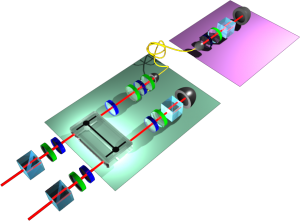Hardy’s paradox and Bell inequalities in time
- Post by: admin
- July 11, 2011
- No Comment
Extending on our previous work on Leggett-Garg inequalities, we recently demonstrated the venerable Hardy paradox and the violation of a state-independent Bell inequality in a temporal scenario. Our work has now appeared in PRL.
Tests of quantum mechanics, such as the Bell inequality, are usually carried out in a spatial scenario, where measurements performed on two or more remote, spatially separated (quantum) systems reveal correlations which are stronger than those allowed in classical models.

They can however also be translated into a temporal scenario, where two or more measurements are performed on the same system, at different times. This idea was cooked up by Tony Leggett and Anupam Garg, motivated by the quest to show that quantum and classical world views were incompatible also for macroscopic objects. The usual assumptions of realism and locality in the spatial scenario are here replaced with the assumptions of (macro)realism and, because locality cannot be enforced for temporal measurements on a single object, non-invasiveness, which posits that a classical measurement on a macro-realistic system can determine the state of the system without affecting either the state or the subsequent system dynamics. Just like in the spatial scenario one can derive inequalities which show a disagreement of quantum mechanics with these assumptions.
In our experiment, we implemented such a temporal scenario with single photons, similar to a previous demonstration of the original Leggett-Garg inequality in our group. The experimental scheme is explained in the figure. Following an idea by Tobias Fritz, we first show that Hardy’s paradox is stronger in its temporal form. Furthermore, we measure the temporal equivalent of a Bell CHSH inequality as suggested by Caslav Brukner and colleagues. Surprisingly, the violation of this inequality is not dependent on the quantum state, which means it can be maximally violated by any state, including fully mixed states.